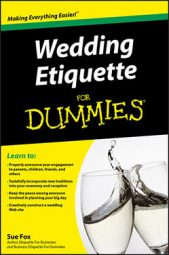At a wedding, ushers escort guests to their seats — that's pretty common knowledge. The task of escorting guests to the proper seats falls to the ceremony’s ushers — it’s their job to know who sits where. After your guests have been greeted and have signed the guest book, they are taken to their seats.
Seating guests smoothly
Some larger weddings designate certain guests to receive within-the-ribbon or pew cards, which they present to the ushers so they are led to certain seats in designated rows. Other guests are often asked, “Bride or groom?” by the ushers in order to know to which side of the sanctuary to lead them. The bride’s friends and family traditionally sit on her side of the ceremony site, while the groom’s friends and family sit on his side.
In a Christian wedding, the bride’s side is to the left of the aisle when facing the altar, and the groom’s side is to the right of the aisle. A Jewish wedding is reversed. If you’re conducting a wedding from other cultures or faiths, or a blended service, consult someone knowledgeable in the finer points of your desired ceremony style. Also note that many couples now choose to mix their guests and eliminate the bride and groom’s sides altogether.
Understanding where family members sit
The first row is reserved for any member of the wedding party who feels ill or faint (or for all the attendants in a long ceremony). The parents of the bride and groom and any siblings who aren’t in the wedding are seated next to the aisle in the second row. The third row is reserved for grandparents and siblings who do not sit in the second row. Other honored guests, such as elderly relatives, aunts, uncles, cousins, godparents, those doing special readings or parents of children in the ceremony are seated in the fourth row. Those in the first three rows are seated by the ushers immediately before the ceremony, while those in the fourth row are seated with the other guests.
Filling the seats
Ushers should fill the pews from front to back of the ceremony site, reserving the first few rows for close family members and special guests. If one side fills up more than the other, ushers should seat guests to make the rows look even, after politely asking guests if they mind. Response cards should give you a clue about the possibility of uneven sides, and you can alert your ushers accordingly.
Another alternative, if you’re disregarding the tradition bride and groom’s sides, is to fill the rows evenly from front to back. Well-mannered guests will comply, but if a guest insists on a certain seat, the guest wins.
Guests who arrive after ushers have started to escort the immediate family may sit or stand in the back of the site until after the processional has reached the front and the bride has been presented to the groom. Late guests should use side aisles to slip quickly and quietly into rear seats without disturbing other guests.
It’s perfectly acceptable for guests to seat themselves if the wedding is large and the number of guests waiting to be escorted down the aisle is multiplying or it’s almost time for the wedding to begin.

